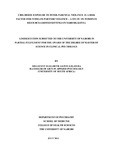| dc.description.abstract | Intimate partner violence (IPV) is a common and serious public health concern in many parts
of the world. Exposure to psychological and physical abuse has been established as a risk
factor for children‘s socio-emotional, behavioural, and cognitive problems (Cummings M,
2009). When parents fight, children may attempt to intervene in the violent episode resulting
in physical, psychological, and emotional injury. One of the main reasons why gender based
domestic violence (GBDV) and IPV do not recede has to do with poor reporting of
incidences of violence. Increasing research on the area of domestic violence in Kenya has
yielded information to help understand that this is an immense problem in our society.
This study investigated the relationship between witnessing domestic violence in childhood
and experiencing inter-partner violence in adulthood. It was a cross-sectional study with a
sample size of 198 women. Participants of the study were married and unmarried women of
low socioeconomic status, aged 18 and above. The study site was within the 8 villages of the
Mukuru slums, in Nairobi, Kenya. The study used a mixed method (quantitative and
qualitative) study. Data was collected using questionnaires and focus group discussions.
Main Objective
To determine the prevalence of Inter Parental Violence as a risk factor of Intimate Partner
Violence.
Methodology
The study was a cross-sectional field-based study that used questionnaires and two focus
group discussions. Convenience sampling was used for the quantitative part of the study and
purposive sampling was used for qualitative. All eligible participants who consented were
included in the study until the researcher achieved the desired sample size of 198
respondents. Focus group discussions were done until saturation was reached. Data was
collected by administering a socio-demographic questionnaire, an intimate partner violence
questionnaire; a researcher designed witnessing questionnaire, a learned helplessness
questionnaire, and a focus group discussion for the qualitative arm of the research.
Questionnaires were coded and the results were tabulated using Microsoft Excel. Quantitative
data was analysed using the computer software SPSS Version 17 to reveal the emerging
patterns and presented in the form of tables, bar charts and pie charts. Focus group
discussions were recorded and transcribed. Thematic analysis was used to analyse the
qualitative data. The researcher observed all ethical considerations.
Results
The average age of the 198 participants was 34 years; the youngest was 19 years old and the
eldest 61 years old. Intimate Partner Violence prevalence within this population stands at 153
(77%). From this analysis, 116 (60%) respondents report witnessing inter-parental violence
as children. The average age of those exposed to intimate partner violence was 36 years
compared to 28 years for those who were not exposed. The youngest participant was 19 years
old while the eldest was 61 years of age. Findings indicate that risk of exposure to intimate
partner violence increases with age F=24[95% CI Interval for mean 34 – 37] p=<0.0001. 59
(50%) respondents born before 1980 witnessed inter-partner violence while 33 (28%) of
those born between 1981 and 1990 witnessed violence in the home. Of those born after 1991,
26 (22%) witnessed inter-partner violence in childhood.
Results indicate that witnessing interparental violence, age and marital status are strongly
correlated to intimate partner violence in adulthood. Multivariate analysis demonstrate that
older participants are more likely to experience violence with risk likely to increase by 7%
with each increasing year in age OR=1.071[95%CI of OR, 1.02 – 1.12], p=0.002. Those
married or in a relationship are twice as likely to report IPV in adulthood OR=2.1[95% CI of
OR, 1.2 – 3.6], p=0.007. Participants who witnessed violence in their childhood are 3 times
more likely to report IPV in adulthood OR=2.7 [95% CI of OR, 1.3 – 5.8], p=0.008. The
study also found that approximately half (43%) the sample had moderate to high levels of
learned helplessness. Learned helplessness has a strong positive correlation with exposure to
IPV in adulthood (p=0.008). Focus group discussion results indicate that the contributing
factors to intimate partner violence include economic hardship, alcohol and drug abuse, and
traditional beliefs.
Conclusion
The study found a strong positive correlation between witnessing family of origin violence
and violence in adulthood remained even after adjusting for confounders. The increasing age
of the woman was also a high risk factor to exposure to intimate partner violence in
adulthood. The null hypothesis was therefore rejected. The study also found strong
correlations between being married or in a relationship and intimate partner violence. | en_US |
| dc.description.department | a
Department of Psychiatry, University of Nairobi, ; bDepartment of Mental Health, School of Medicine,
Moi University, Eldoret, Kenya | |

